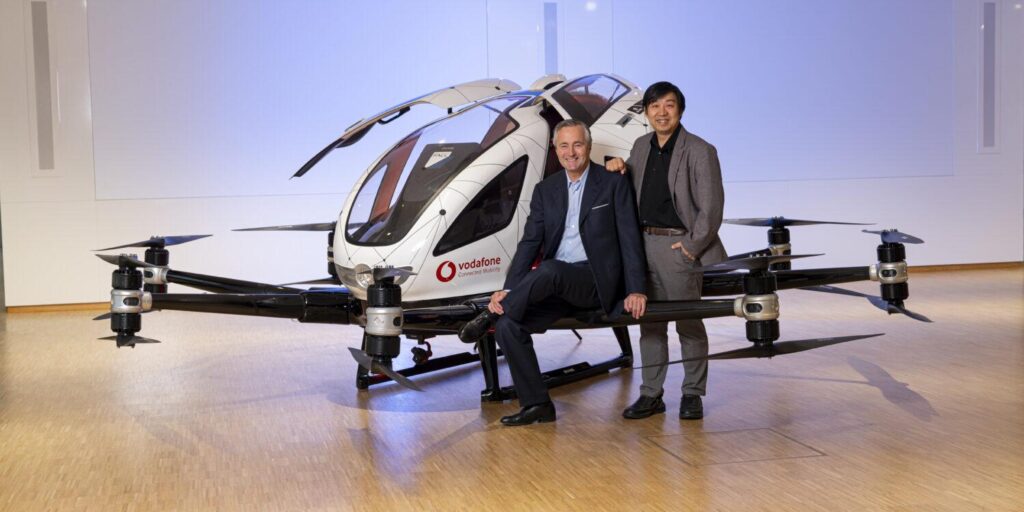Revolutionizing Urban Transit: EHang’s Ambitious Flying Taxi Initiative for 2030
In a bold stride toward transforming city transportation, Chinese drone innovator EHang has unveiled plans to introduce routine flying taxi services by the year 2030. Renowned for its breakthroughs in aerial vehicle technology, EHang envisions electric vertical takeoff and landing (eVTOL) aircraft as a game-changer for urban mobility, especially in densely populated metropolitan areas. As global demand surges for sustainable and efficient transit alternatives, this initiative could not only redefine how cities function but also tackle urgent issues like urban congestion and environmental pollution. Positioned at the cutting edge of drone evolution, EHang is igniting discussions around the necessary logistics, regulatory frameworks, and infrastructure to support this new mode of aerial commuting.
Pioneering Urban Air Mobility: Charting EHang’s Path to 2030
With urban populations expanding rapidly worldwide—projected to reach nearly 70% by 2050 according to UN estimates—the urgency for innovative transport solutions intensifies. Recognizing this trend, EHang aims to embed flying taxis into cityscapes within the next decade. The company believes that eVTOLs can dramatically reduce road traffic bottlenecks while offering commuters faster travel options compared to conventional vehicles.
EHang’s comprehensive approach extends beyond just manufacturing advanced aerial vehicles; it includes developing an integrated ecosystem featuring charging hubs strategically placed across cities and sophisticated flight control systems designed with safety as a priority.
- Cutting-edge Technology: Continuous R&D investments focus on improving flight stability, autonomous navigation capabilities, and system reliability.
- Regulatory Engagement: Active collaboration with aviation authorities worldwide aims at crafting policies that ensure safe integration of flying taxis into crowded airspaces.
- Cultivating Public Trust: Educational campaigns are underway to familiarize communities with eVTOL benefits while addressing safety concerns.
- Sustainability Commitment: Designs emphasize zero-emission operations aligned with global climate goals promoting greener urban environments.
The company is also forging strategic alliances with municipal governments and private sector partners. These collaborations are critical in resolving challenges such as airspace coordination protocols and emergency response mechanisms—key factors that will determine successful deployment by 2030. This roadmap balances visionary ambition with pragmatic steps toward reshaping future city transit networks globally.
The Technological Backbone Powering Next-Gen Flying Taxis
The transformation sweeping through urban transportation owes much to rapid advancements in drone technologies enabling practical flying taxi services. Industry leaders like EHang harness innovations including fully autonomous piloting systems powered by artificial intelligence (AI), efficient electric propulsion via eVTOL designs capable of vertical takeoff from compact spaces, and AI-enhanced traffic management platforms ensuring smooth operation amid complex air corridors.
This surge in technological progress is matched by growing capital inflows; recent market analyses forecast the global eVTOL market could exceed $20 billion by 2035 due largely to rising consumer interest in alternative mobility solutions that ease ground-level congestion while reducing carbon footprints.
- Batteries & Powertrains: Breakthroughs in lithium-sulfur batteries promise longer flights exceeding one hour per charge alongside reduced maintenance costs compared to earlier models.
- Sophisticated Safety Systems: Multi-layered sensor arrays combined with redundant fail-safe controls enhance passenger protection during all phases of flight operations.
- User-Centric Platforms: Seamless mobile applications integrating ride booking, real-time tracking, dynamic pricing models, and contactless payments aim at delivering hassle-free user experiences akin to popular ride-sharing apps today.
| Aerospace Innovator | Main Contribution |
|---|---|
| EHang | Pioneers autonomous eVTOL development focused on scalable urban air taxi fleets; |
| AeroMobil | Create hybrid vehicles capable of transitioning between driving on roads and airborne travel; |
| Lilium Aviation | Diversify electric jet-powered VTOL aircraft targeting regional commuter routes; |
Navigating Regulatory Complexities: Strategies Essential for Market Success
The widespread adoption of flying taxis hinges heavily upon overcoming intricate regulatory barriers which vary significantly across jurisdictions worldwide. Governments must establish robust frameworks addressing safety certification standards alongside effective management systems tailored specifically for low-altitude urban airspace crowded increasingly by drones delivering goods or conducting surveillance missions alongside passenger craft like those envisioned by EHang.
- Air Traffic Coordination Systems : Developing centralized digital platforms capable of real-time monitoring & deconfliction among hundreds or thousands of simultaneous flights over metropolitan zones . li >
- Safety Protocols : Instituting stringent design certifications , pilot training requirements (even if autonomous ), plus emergency contingency procedures . li >
- Community Engagement : Proactively involving residents through public consultations helps mitigate concerns about noise pollution , privacy infringement , or ecological disturbances caused by increased aerial activity . li >
ul >EHang’s success will depend largely on proactive partnerships forged early between regulators at national/local levels combined with transparent data sharing from pilot programs demonstrating operational viability under controlled conditions.
Leveraging lessons learned from countries already advancing their regulatory landscapes can accelerate approvals elsewhere — examples include Germany where trial flights have been authorized since late 2023 or U.S.-based pilot initiatives slated through mid-decade timelines.Country / Region Regulatory Progress Status Projected Service Launch Year < td >United States Pilot testing ongoing under FAA oversight 2025 tr > < td >United Kingdom DRAFT regulations undergoing consultation phase 2026 tr > < td >Germany Civil aviation authority approved limited commercial trials since late 2023 2024 tr > < td >China Mature pilot projects supported regionally ahead full-scale rollout plan/t d2030 tr > A Glimpse Ahead: The Future Skyline Filled With Flying Taxis?
EHang’s vision targeting regularized flying taxi operations within this decade signals a transformative chapter poised not only technologically but socially as well — redefining how millions navigate sprawling megacities burdened daily by gridlock delays.
While hurdles remain concerning infrastructure readiness , public acceptance , noise mitigation strategies , plus comprehensive regulation enforcement — momentum continues building steadily.
As stakeholders ranging from policymakers through tech innovators monitor these developments closely over coming years , it becomes clear our skies may soon mirror streets bustling below — ushering an era where airborne commutes become integral components shaping sustainable smart cities globally.
p >
